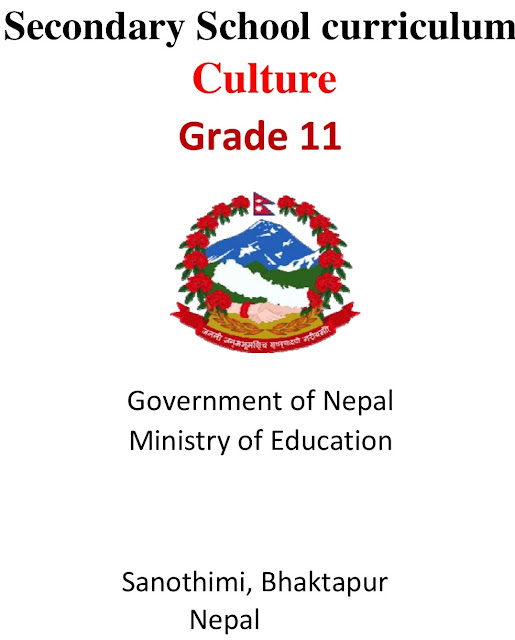The study of Culture (Culture NEB Syllabus) helps understand the dynamics of human society and provides a sound knowledge of the present and the future problems that the human race may encounter. This course has been devised incorporating the various elements of culture since the very dawn of human civilization to understand the dynamism of the culture of Nepal.
Disclaimer: This is the old syllabus of NEB.For 2076 Updated syllabus with PDF download option,visit: NEB 2076 Updated Syllabus
Grade XI NEB Syllabus – Culture Syllabus
Culture NEB Syllabus: Grade XI NEB Syllabus
GRADE XI
Full marks: 100
Teaching hours: 150
I. Introduction of Culture NEB Syllabus
The study of culture helps understand the dynamics of human society and provides a sound knowledge of the present and the future problems that the human race may encounter. This course has been devised incorporating the various elements of culture since the very dawn of human civilization to understand the dynamism of the culture of Nepal. This course will help the students to appreciate the gnosis of the evolution of human culture, particularly of numerous ethnic groups practicing their socio-cultural traditions and political and economic systems in different forms.
II. General Objectives of Culture NEB Syllabus
The general objectives of the Culture Syllabus course are:
a. To enable the students to appreciate the niceties of Nepal’s historical tradition of different periods; and
b. To acquaint them with the basic cultural life of various ethnic groups of Nepal.
III. Specific Objectives of Culture NEB Syllabus
On the completion of the Culture Syllabus course, the students will be able to identify a. Nepal’s traditional and documented history; and
b. Nepal’s social and religious tradition in historical perspective as well as the significance of various festivals and sacraments practiced by the people in the country.
IV. Course contents of Culture NEB Syllabus
Section- A. Political History of Nepal (60 marks) – 90 Teaching hrs
1.Introductory studies:
• Definition of history and culture and their relations with Anthropology and Archaeology
• Sources:
i. Archaeological
ii. Literary, and
iii. Foreign accounts.
2. A brief history of the Gopalas, Mahisapalas, Kiratas, Shakyas of Kapilvastu and Videhas of Janakpur.
• Political history of the Lichchhavi and Malaa periods with special reference to the following rulers:
Manadeva, Amsuvarma, Narendra Deva, Shiva Deva II, and Jaya Deva, Raghava Deva and Introduction of Nepal Era, Gunakama Deva, and Ari Malla.
• Jayasthitimalla. Yakshamalla, Rayamalla, Jitamitramalla Bhupatindramalla and Ranjit Malla of Bhaktapur.
• Ratnamalla, Mahendra Malla, Laxinarasinghamalla, Pratapmalla, and Jaya Prakash Malla of Kathmandu
• Siddhinarsinghamalla, Srinivasa Malla, Yognarendramalla and Six Pradhans of Patan.
• Causes for the fall of the Mallas.
• Social and administrative condition of the Nepal Valley during the Lichchhavi and Malla periods.
• A brief study of the unification of Nepal: Contributions of Prithvi Narayan Shah, Rajendra Laxmi Devi, and Bahadur Shah.
• A brief study of the Nepal East India Company War of 1814-16 and the Treaty of Sugauli.
Section- B Cultural History of Nepal (40 marks) – 60 teaching hrs
• Main features of the Varnashram system:- Main sacraments of the Hindu and Buddhist societies: Education- aims and ideals: Ancient Educational System of the Hindus and Buddhists; Relation between the teachers and students.
• Hinduism:- Vedic and Upanisadic religions; important Vedic Deities:- Rudra, Surya, Varuna, Vac, and Indra.
• Buddhism:- Life and teaching of Lord Buddha; an introduction to Hinayana, Mahayana and Vajrayana Buddhism and the major difference in these schools.
• A brief study of Shaivism, Shaktism, and Vaishnavism in Nepal.
• People of Nepal :- A brief study of the area of settlement social structure, sacraments, religion, and festivals of the Sherpa. Gurung, Kirata, Newar and
• Study of the Main Festivals of Nepal :- Dashain, Tihar, Buddha Jayanti, Shivaratri, Vasanta Panchami, Ghode Jatra, Rato Matsyendranath Jatra, Chhath, Vibaha Panchami and Losar Tharu communities of Nepal.
V. Reference books
1. bfxfn, k]zn, g]kfnsf] Oltxf; / ;+:s[lt, Pd=s]= klAn;;{, ef]6flx6L
2. Bista, D. B. People of Nepal
3. Pokharel, G. P. Nepala Rajyako Etihasika Vritanta
4. Parbhu, P. N. Hindu Social Organization
5. Regmi, .J. C., Nepalako Dharmika Itihasa
6. Shrestha, H.P., Nepalako Itihasa ra Samskriti Eka Jhalaka
People who read this may also like to read All others Grade XI/XI NEB Syllabus.
Or Download All NEB updated syllabus NEB 2076 Updated Syllabus
